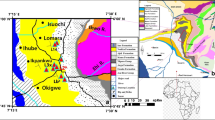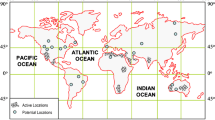Abstract
The characteristics of climatic, lithological and geomorphological conditions of formation of sandy soils of Transbaikalia (Barguzin basin) is given. It has been established that the main soil-forming processes are cryo- and light-humus, accumulative-carbonate and pale-metamorphic. In the soils of deposits, the processes of stratification and abrasion are expressed. Moving sands are not affected by soil formation, but with partial fixation of herbaceous and/or shrub vegetation on them, embryonic underdeveloped soils (layered-eolian, humus psammozems) begin to develop. For the first time, the results of the material composition of the rocks of the Angara-Vitim batholith, soil-forming sand, as well as the composition of minerals of fractions <1.1–5 and >5 µm of cryohumus and light humus soils are presented. It has been determined that the regional features of soil-forming sands are carbonation, alkalinity, and polymineral content, which is inherited from calc-alkaline rocks. The sandy and silty soil fractions have a similar mineralogical composition, which are characterized by a high content of plagioclases and K-feldspars and a low content of quartz. The composition of the silty fraction consists of a mixed-layer phase of illite-smectites interbedded with single chlorite packets, di-trioctadridic illite, ferruginous chlorite, and kaolinite. Modern soil formation is characterized by a low degree of chemical weathering (CWC, CWI, and GM) and weak profile differentiation. A feature of the material composition of sandy soils is an increased content of potassium and sodium. According to the values of total alkalinity, the studied soils are highly alkaline soils. There is a clearly pronounced division of the soil profile according to biological activity. It was revealed that during arable use, sandy soils are potential centers of desertification: in the studied area, all arable lands and fallows located on them are deflated to varying degrees. At the same time, it was found that more than 70% belong to very strongly deflated and strongly deflated types. In such areas, humus soil layers are blown out and carbonate horizons and even soil-forming sands are exposed. The exposed middle horizons and sands do not possess elements of effective fertility. The yield of agricultural crops on such arable lands is very low, the process of natural restoration of vegetation cover on fallow lands is extremely difficult, and deflation ulcers practically do not overgrow. The inhibition of the processes of restoration of natural cenoses is largely due to the alkalinity and carbonation of soil-forming sands.


Similar content being viewed by others
REFERENCES
Agrokhimicheskie metody issledovaniya pochv (Agrochemical Methods of Soil Research), Moscow: Nauka, 1975.
Bazha, S.N., Danzhalova, E.V., Drobyshev, Yu.I., and Khadbaatar, S., Transformation of terrestrial ecosystems in the southern part of the Baikal basin, in Biologicheskie resursy i prirodnye usloviya Mongolii: Trudy Sovmestnoi Rossiisko-Mongol’skoi kompleksnoi biologicheskoi ekspeditsii (Biological Resources and Natural Conditions of Mongolia: Proceedings of the Joint Russian-Mongolian Complex Biological Expedition), Moscow: KMK, 2018, vol. 63.
Borodin, L.S., The Angaro-Vitim batholith granites: Model petrochemical and genetic analysis, Litosfera, 2009, no. 4, pp. 40–56.
Brown, G., The X-Ray Identification and Crystal Structures of Clay Minerals, London: Mineralogical Society (Clay Minerals Group), 1961.
Chizhikova, N.P. and Lebedeva, M.P., Transformation of clay minerals in soils of sandy deserts under different saxaul species, Byull. Pochv. Inst., 2014, no. 76, pp. 74–90.
Chizhikova, N.P., Efstifeev, Yu.G., and Pankova, E.I., Mineralogical composition of the clay fraction of desert soils, Pochvovedenie, 1988, no. 8, pp. 44–55.
Cox, R., Lowe, D.R., and Cullers, R.L., The influence of sediment recycling and basement composition on evolution of mudrock chemistry in Southwestern United States, Geochim. Cosmochim. Acta, 1995, vol. 59, pp. 2919–2940.
Fedo, C.M., Nesbitt, H.W., and Young, G.M., Unraveling the effects of potassium metasomatism in sedimentary rocks and paleosols, with implications for paleoweathering conditions and provenance, Geology, 1995, vol. 23, pp. 921–924.
Gorbunov, N.I., Methods of preparing soils for mineralogical analyses, in Metody mineralogicheskogo i mikromorfologicheskogo izucheniya pochv (Methods of Mineralogical and Micromorphological Study of Soils), Moscow: Nauka, 1971, pp. 5–15.
Gradusov, B.P., Mineraly so smeshanosloinoi strukturoi v pochvakh (Soil Minerals with a Mixed Layer Structure), Moscow: Nauka, 1976.
Gunin, P.D., Ekologiya protsessov opustynivaniya aridnykh ekosistem (Ecology of Desertification Processes in Arid Ecosystems), Moscow: Vsesoyuznaya Akademiya Sel’skokhozyaistvennykh Nauk Imeni V. I. Lenina, 1990.
Gunin, P.D., Ubugunov, V.L., Rupyshev, Yu.A., Ubugunova, V.I., Bazha, S.N., Balsanova, L.D., Baldanov, B.Ts., Buyantueva, L.B., Harpuhayeva, T.M., Holboeva, S.A., Petukhov, I.A., and Tsyrempilov, E.G., Role of biotic and abiotic factors in the processes of soil encrustation on fallow lands of the Barguzin Hollow, Arid Ecosyst., 2018, vol. 8, no. 3, pp. 161–172.
Gurinov, A.L., Lukashov, A.A., and Rogov, V.V., Specific features of granite weathering in the Transbaikal region, Vestn. Mosk. Univ., Ser. 5: Geogr., 2014, no. 2, pp. 49–54.
Ivanov, A.D., Eolovye peski Zapadnogo Zabaikal’ya i Pribaikal’ya (Eolian Sands of Western Transbaikalia and the Baikal Region), Ulan-Ude: Buryatsk. Kompleksnyi Nauchno-Issled. Inst. Sib. Otd. Akad. Nauk SSSR, 1966.
Kalinin, P.I., Alekseev, A.O., and Savko, A.D., Loesses, paleosols and paleogeography of the Quaternary of the southeast of the Russian Plain, Trudy Nauchno-Issled. Inst. Geologii Voronezhsk. Gos. Univ., 2009, no. 58.
Khassan, A.I., Cenozoic complexes of sedimentary deposits in the axial Barguzin and Tunka valleys of the Baikal rift system, Extended Abstract of Cand. Sci. (Geol.-Mineral.) Dissertation, Irkutsk, 2022.
Khassan, A.I., Kolomiets, V.L., Rasskazov, S.V., Budaev, R.Ts., Chuvashova, I.S., and Al’ Khamud, A., Paleopotamology of pleistocene sediments in the Barguzin Valley (Baikal rift zone), Vestn. Voronezh. Gos. Univ., Ser.: Geol., 2019, no. 4, pp. 37–46.
Klassifikatsiya i diagnostika pochv Rossii (Classification and Diagnostics of Russian Soils), Shishov, L.L., Tonkonogov, V.D., Lebedev, I.I., and Gerasimov, M.I., Eds., Smolensk: Oikumena, 2004.
Konishchev, V.N. and Rogov, V.V., Experimental model of cryogenic stability of the main rock-forming minerals, Probl. Kriolitol., 1978, no. 7, pp. 187–197.
Litvinovskii, B.A., Zanvilevich, A.N., Alakshin, A.M., and Podladchikov, Yu.Yu., Angaro-Vitimskii batolit— krupneishii granitoidnyi pluton (The Angara-Vitim Batholith is the Largest Granitoid Pluton), Novosibirsk: Izd. Ob"edinennogo Inst. Geol., Geofiziki i Mineral. Sib. Otd. Ross. Akad. Nauk, 1993.
Maslov, A.V., Osadochnye porody: metody izucheniya i interpretatsii poluchennykh dannykh (Sedimentary Rocks: Methods of Studying and Interpreting the Obtained Data), Yekaterinburg: Ural’sk. Gos. Gorn. Univ., 2005.
Mats, V.D., Ufimtsev, G.F., Mandel’baum, M.M., Alakshin, A.M., Pospeev, A.V., Shimaraev, M.N., and Khlystov, O.M., Kainozoi Baikal’skoi riftovoi vpadiny: stroenie i geologicheskaya istoriya (Cenozoic of the Baikal Rift Basin: Structure and Geological History), Novosibirsk: Geo, 2001.
Munsell Color System, 2018. http://colory.ru/mansellcolorsheme. Cited February 6, 2023.
Namzalov, B.B. and Baskhaeva, T.G., Gornaya letopis' Barguzinskoi kotloviny (Severnoe Pribaikal’e) (Mountain Chronicle of the Barguzin Hollow (Northern Baikal Region)), Ulan-Ude: Buryatsk. Gos. Univ., 2006.
Nesbilt, H.W. and Young, G.M., Early proterozoic climates and plate motions inferred from major element chemistry of lutites, Nature, 1982, vol. 299, pp. 1523–1534.
Noskov, D.A., Geochemical features and formation conditions of the Angara-Vitim granitoid batholith (Eastern Baikal region), Extended Abstract of Cand. Sci. (Geol.-Mineral.) Dissertation, Irkutsk, 2011.
Polevoi opredelitel' pochv Rossii (Field Guide to Russian Soils), Moscow: Pochven. Instit., 2008.
Retallack, G.J., Soils of the Past: An Introduction to Paleopedology, Oxford: Blackwell, 2001, 2nd ed.
Rogov, V.V., The morphology of particles of the cryogenic alluvium skeleton, Kriosfera Zemli, 2000, vol. 4, no. 3, pp. 67–73.
Shaldybin, M.V., Shein, E.V., Kharitonova, G.V., Dembovetskii, A.V., Manucharov, A.S., Lopushnyak, Yu.M., and Konovalova, N.S., Mineralogical composition of Baer mound soils, southern Astrakhan Oblast, Vestn. Mosk. Univ., Ser. 17: Pochvoved., 2015, no. 1, pp. 3–12.
Sokolova, T.A., Dronova, T.Ya., and Tolpeshta, I.I., Glinistye mineraly v pochvakh (Clay Minerals in Soils), Moscow: Nedra, 2005.
Tohru, O. and Hiroyosbi, A., Statistical empirical index of chemical weathering in igneous rocks: A new tool for evaluating the degree of weathering, Chem. Geol., 2007, vol. 240, pp. 280–297.
Tsygankov, A.A., Late paleozoic granitoids in Western Transbaikalia: Sequence of formation, sources of magmas, and geodynamics, Geol. Geofiz., 2014, vol. 55, no. 2, pp. 197–227.
Tsyrempilov, E.G., Ubugunov, V.L., Ubugunova, V.I., and Aleskerova, E.N., Morphogenetic properties of the steppe soils of Verhniy Kuitun Tract (Barguzin Depression, Buryatia), Izv. Irkutsk. Gos. Univ., Ser. “Biol., Ekol.”, 2018, vol. 26, pp. 54–68.
Ubugunov, V.L. and Ubugunova, V.I., Soil-forming rocks are the key to understanding the soil formation uniqueness in West Transbaikalia, Priroda Vnutrennei Azii (Nature of Inner Asia), 2017, no. 4 (5), pp. 25–39.
Ubugunov, V.L., Ubugunova, V.I., and Tsyrempilov, E.G., Pochvy i formy rel’efa Barguzinskoi kotloviny (Soils and Landforms of the Barguzin Depression), Ulan-Ude: Buryatsk. Nauchnyi Tsentr Sib. Otd. Ross. Akad. Nauk, 2016.
Ubugunov, V.L., Ubugunova, V.I., Zhambalova, A.D., Khobrakova, L.Ts., and Aleskerova, E.N., Soils of sandy massifs of the Barguzin Hollow: Diversity and patterns of spatial distribution, Priroda Vnutrennei Azii, 2017, no. 3(4), pp. 75–89.
Yudovich, Ya.E. and Ketris, M.P., Osnovy litokhimii (Fundamentals of Lithochemistry), St. Petersburg: Nauka, 2000.
Funding
The work was done on the topics of state assignments: Institute of General and Experimental Biology Siberian Branch, Russian Academy of Sciences Evolutionary-genetic, biogeochemical and production functions of the soils of the Baikal region as a component of the biosphere, assessment of their resource potential and development of technologies for rational use and protection (No. 121030100228-4) and A.N. Severtsov Institute of Ecology and Evolution, Russian Academy of Sciences, Historical ecology and biogeocenology (No. 0109-2019-0007), with the support of the Filippova Buryat State Agricultural Academy (Theme I, Sub-theme I.03).
Author information
Authors and Affiliations
Corresponding authors
Ethics declarations
Conflict of interests. The authors declare that they have no conflicts of interest.
Rights and permissions
About this article
Cite this article
Ubugunova, V.I., Ubugunov, V.L., Varlamov, E.B. et al. Peculiarities of the Mineralogical and Material Composition of Sands and Sandy Soils in the Cainozoic Deeps of Transbaikalia. Arid Ecosyst 13, 441–451 (2023). https://doi.org/10.1134/S2079096123040169
Received:
Revised:
Accepted:
Published:
Issue Date:
DOI: https://doi.org/10.1134/S2079096123040169




